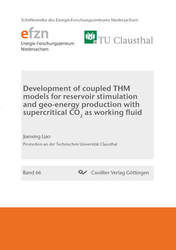| Areas | |
|---|---|
| Serie de libros (96) |
1378
|
| Nachhaltigkeit |
3
|
| Gesundheitswesen |
1
|
| Letra |
2364
|
| Ciencias Naturales |
5406
|
| Ciencias Ingeniería |
1793
|
| Ingeniería | 292 |
| Ingeniería mecánica y de proceso | 862 |
| Ingeniería eléctrica | 686 |
| Mineria y metalurgía | 30 |
| Arquitectura e ingeniería civil | 75 |
| General |
98
|
|
Leitlinien Unfallchirurgie
5. Auflage bestellen |
|
Erweiterte Suche
Development of coupled THM models for reservoir stimulation and geo-energy production with supercritical CO2 as working fluid (Volumen 66) (Tienda española)
Jianxing Liao (Autor)Previo
Lectura de prueba, PDF (1,7 MB)
Indice, PDF (130 KB)
In this dissertation, two specific numerical models have been developed to address the issues associated with utilization of supercritical CO2, like fracture creation, proppant placement and fracture closure in unconventional gas reservoirs, reservoir stimulation, heat production and CO2 sequestration in deep geothermal reservoirs, respectively. In unconventional gas reservoir, the model consisting of classic fracture model, proppant transport model as well as temperature-sensitive fracturing fluids (CO2, thickened CO2 and guar gum) has been integrated into the popular THM coupled framework (TOUGH2MP-FLAC3D), which has the ability to simulate single fracture propagation driven by different fracturing fluids in non-isothermal condition. To characterize the fracture network propagation and internal multi fluids behavior in deep geothermal reservoirs, an anisotropic permeability model on the foundation of the continuum anisotropic damage model has been developed and integrated into the popular THM coupled framework (TOUGH2MP-FLAC3D) as well. This model has the potential to simulate the reservoir stimulation and heat extraction based on a CO2-EGS concept.
| ISBN-13 (Impresion) | 9783736972421 |
| ISBN-13 (E-Book) | 9783736962422 |
| Formato | A5 |
| Idioma | Inglés |
| Numero de paginas | 180 |
| Edicion | 1 |
| Serie | Schriftenreihe des Energie-Forschungszentrums Niedersachsen (EFZN) |
| Volumen | 66 |
| Lugar de publicacion | Göttingen |
| Lugar de la disertacion | Clausthal |
| Fecha de publicacion | 28.07.2020 |
| Clasificacion simple | Tesis doctoral |
| Area |
Mecánica de medida
|
| Palabras claves | Numerical model, Supercritical CO2 , THM coupling, Tight gas reservoir, CO2-EGS, Reservoir stimulation, Heat production, CO2 sequestration, Gas-based fracturing , Multi-Phase, Porous flow, Fracture flow, Geoenergie, Proppantplatzierung, Frakturerzeugung, Gaslagerstätten, Lagerstättenstimulierung, geothermische Reservoirs, Fracturing-Fähigkeit, Proppant-Tragfähigkeit, Guarkernmehl, Unterdruck, Viskosität, Leckrate, Expansionseffekt, Ausdehnungseffekt, Schadensdurchlässigkeitsmodell, Permeabilität, Prioritätskanal, Endtemperatur, fracture generation, proppant placement, gas deposits, reservoir Stimulation, Vacuum, leakage rate, expansion effect, final temperature, time discretization, Zeitdiskretisierung, thermal dynamic properties, Modellverifizierung, Gasvorkommen, Injektionsloch, Produktionsbohrung, Segmente, segments, model verification, Speichergestein, Wasserknappheit, Wirtsgesteinstyp, Vulkangestein, volcanic stone |








